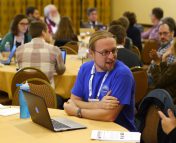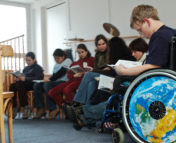Disclosure: The Dunlap Institute for Astronomy & Astrophysics is listed as a partner on the Astrodigenous website and provides funding for the program. The author of this piece works in an unrelated outreach program through the Dunlap Institute.
“Science is not universal,” wrote Dr. Hilding Neilson, Astronomer, at the end of a blog post in 2017. “It, like most everything in humanity, is cultural and biased by our beliefs. We, as scientists, need to remember that more often.”
Neilson, like many academics in astronomy, is more than just an astronomer. He’s an assistant professor at Memorial University of Newfoundland, situated on the traditional lands of the Beothuk and Mi’kmaq peoples, where he works on astrophysics and its intersections with Indigenous knowledge. He’s a Mi’kmaw person, making him one of a very, very small number of Indigenous people working as astronomers on Turtle Island. He’s a teacher, he’s an outreach specialist, he’s a stellar astrophysicist using theoretical methods to probe the physics of stars. And he’s the creator of Astrodigenous, a tool designed to help pre-university-level teachers weave Indigenous Astronomy Knowledges into their curricula.
The website serves as a compendium of resources — largely writings, oral records, and activities — documenting tales of the sky and astronomy practices from Indigenous peoples of Turtle Island.
According to Dr. Heidi White, a member of the Astrodigenous team, the project was Neilson’s “brainchild.” Neilson, however, attributes the origin and subsequent growth of the resource to the students who worked on it.
“The idea was brought to me by a student in education, Michael O’Shea. It started with a first search of resources on an Excel sheet and grew from there. Heidi and Christina [Nitsis] joined as well and took it in directions I couldn’t have imagined.” (All past and present team members — also including Julie Bolduc-Duval, Charlotte Clark, and Alysa Obertas — are listed on their About page.)
Over the past several years, the Astrodigenous team has curated a collection of resources on Indigenous Astronomy Knowledges and Ways of Knowing. These resources are geared toward pre-university, K–12 students, in part because of the structure of the educational system in Canada. Teachers in most provinces are required, at some point in a child’s education, to incorporate Indigenous knowledges into their curriculum. Yet, says Neilson, “a lot of people just don’t know where to start.”
“A lot of times what people want is a story,” he noted. “It’s very easy to tell an Indigenous sky story, but if people aren’t engaging with it, it very quickly becomes a superficial checkbox.”
The website serves a dual purpose: it helps educators go beyond that checkbox and, as Neilson pointed out, it relieves a burden on Indigenous elders and knowledge holders to provide guidance to settler-background educators.
Today, the resource portal includes hundreds of items, which teachers are encouraged to use throughout their curricula. It also features several documents outlining how to effectively utilize these items, including notes on proper use of certain resources and journaling exercises intended for teachers to complete before using the materials.
“A lot of educators are overworked, so to add something new to their curriculum is challenging unless it’s something they can plug in,” Neilson pointed out. “Unfortunately, that sort of plug-and-play is inappropriate. Trying to find that balance of what is accessible [to educators] and what is appropriate is important.” The exercises make an effort to strike that balance.
“Those supporting documents are for settler-background teachers,” explained White, an astronomer by trade, who said she comes from a settler background herself. “We encourage you, if you are going to use our resources, to please use our journaling exercises to ensure that when you communicate them to your learner, it’s done in a way that is not appropriative.”
The “Positionality Exercises” are deliberately open-ended, asking educators to consider everything from their experiences with the night sky and the land they live on, to the ongoing impacts of colonization on their lives and that land. They close by asking the educator a deeply personal question: why is it important to them that Indigenous Knowledges and Ways of Knowing are included in their classroom?
According to White, these documents address common concerns among teachers. “Teachers are mindful, and they want to do this in a non-appropriative way. But what does that look like? It’s not clear to many of them.”
The website is constantly evolving, and the team notes on their About page that they are “neither knowledge holders, nor facilitators of this knowledge.” According to White, it’s still in a proof-of-concept stage. In June, they embarked on a “formal feedback process” to more comprehensively incorporate input from educators with Indigenous backgrounds into their presentation of materials.
“We feel that [these educators] are best able to assess our platform through the lens of an Indigenous person and as an educator in Canada, and therefore they’re best positioned to provide a very holistic critique.”
The team is looking for feedback on the range of materials available and their accessibility, but especially on the positionality exercises and supportive documents. They want to be sure they “strike the right tone, and that they do reflect an exploration of positionality,” said White.
Following the feedback process — ideally around the end of this summer — the team plans to launch Astrodigenous more formally to teachers. While they have been presenting the resource within astronomy circles, and though the website has been online and pointing users to materials for several years, they are hoping to cover any “blind spots” and have a more complete product before widely promoting it to teachers from settler backgrounds.
Moving forward, the team hopes the website and its resource database will continue to evolve. There’s a page on the website for submitting resources to the database (though the feature is “coming soon!”), and White noted that there are ongoing discussions with educators in the United States about expanding the scope of Astrodigenous’ resources beyond the settler-drawn southern border of Canada.
For now, though the resources available through the website are primarily intended for pre-university educators, they provide a valuable jumping-off point for settler-background astronomers of all ages looking to learn more about Indigenous Astronomy Knowledges.
“Indigenous peoples of Turtle Island and elsewhere have lived on the land long before the scientific revolution and the so-called enlightenment,” Neilson noted in a 2021 blog post. “As part of this land, the peoples developed intimate knowledge of the environment and natural world, including knowledges of the sky above. That understanding was arguably built by centuries of detailed observations that have been shared through stories and usage.”
Astrodigenous, at its core, seeks to continue that sharing for years to come.
Astrobite edited by Janette Suherli
Featured image credit: Astrodigenous





Thank you for sharing! As a MS degree candidate in Space Studies concentration Astronomy/physics and a registered member of the Delaware Tribe (Lenape), this is helpful. Wanishi Anishi. https://bridgetkimsey.com